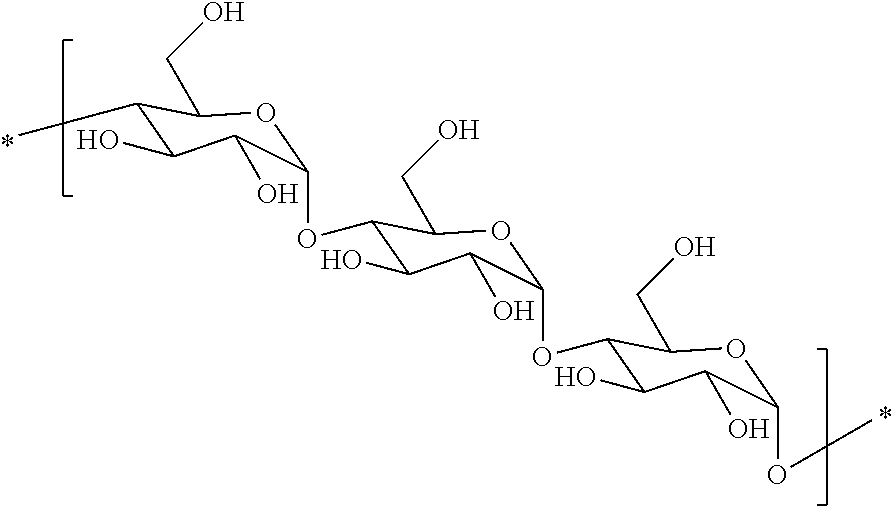Hydrophobic polysaccharides with pendent groups having terminal reactive functionalities and medical uses thereof
a technology of reactive functionalities and hydrophobic polysaccharides, which is applied in the field of hydrophobic derivatives of polysaccharides, can solve the problems of difficult to keep a coated hydrophobic (14)glucopyranose polymer stably, and difficulty in forming a matrix, so as to promote non-enzymatic hydrolysis, reduce the hydrophobicity of the matrix, and increase the susceptibility of the (14)glucopy
- Summary
- Abstract
- Description
- Claims
- Application Information
AI Technical Summary
Benefits of technology
Problems solved by technology
Method used
Image
Examples
example 1
[0146]As shown in the reaction scheme below, maltodextrin is dissolved into dimethylsulfoxide (DMSO) and stirred magnetically until fully dissolved at room temperature. N-Boc-Alanine is dissolved into an aliquot of DMSO, with an equivalent of N,N′-diisopropylcarbodiimide (CDI). This solution is premixed for 30 minutes and then added to the solution of maltodextrin. The catalyst, 4-(dimethylamino)pyridine (DMAP) is added to the final solution to enhance the esterification reaction. The coupling proceeds for 2 hours. The protected amino acid-modified polysaccharide can be purified using dialysis in deionized water in SpectraPor dialysis tubing. Lyophilization will yield the dried polymer. The t-butylcarboxyl (Boc) protecting group can be removed with acid hydrolysis using hydrochloric acid in methanol in an organic solvent. The final polymer can be dialyzed again to remove the cleaved protecting group and solvents, followed by lyophilization to achieve the final modified polysaccharid...
example 2
[0147]As shown in the reaction scheme below, maltodextrin is dissolved into dimethylsulfoxide (DMSO) and stirred magnetically until fully dissolved at room temperature. N-Boc-threonine is dissolved into an aliquot of DMSO, with an equivalent of N,N′-diisopropylcarbodiimide (CDI). This solution is premixed for 30 minutes and then added to the solution of maltodextrin. The catalyst, 4-(dimethylamino)pyridine (DMAP) is added to the final solution to enhance the esterification reaction. The coupling proceeds for 2 hours. The protected amino acid-modified polysaccharide can be purified using dialysis in deionized water in SpectraPor dialysis tubing. Lyophilization will yield the dried polymer. The t-butylcarboxyl (Boc) protecting group can be removed with acid hydrolysis using hydrochloric acid in methanol in an organic solvent. The final polymer can be dialyzed again to remove the cleaved protecting group and solvents, followed by lyophilization to achieve the final modified polysacchar...
example 3
[0148]As shown in the reaction scheme below, maltodextrin is dissolved into dimethylsulfoxide (DMSO) and stirred magnetically until fully dissolved at room temperature. N-Boc-ε-caprolactam is added to the DMSO solution, along with an equivalent of a non-nucleophilic base, such as N-methylmorpholine (NMM). This solution is allowed to react for 120 minutes. The caprolactam-modified polysaccharide can be purified using dialysis in deionized water in SpectraPor dialysis tubing. Lyophilization will yield the dried polymer. The t-butylcarboxyl (Boc) protecting group can be removed with acid hydrolysis using hydrochloric acid in methanol in an organic solvent. The final polymer can be dialyzed again to remove the cleaved protecting group and solvents, followed by lyophilization to achieve the final modified polysaccharide.
PUM
| Property | Measurement | Unit |
|---|---|---|
| weight | aaaaa | aaaaa |
| weight | aaaaa | aaaaa |
| molecular weight | aaaaa | aaaaa |
Abstract
Description
Claims
Application Information
 Login to View More
Login to View More - R&D
- Intellectual Property
- Life Sciences
- Materials
- Tech Scout
- Unparalleled Data Quality
- Higher Quality Content
- 60% Fewer Hallucinations
Browse by: Latest US Patents, China's latest patents, Technical Efficacy Thesaurus, Application Domain, Technology Topic, Popular Technical Reports.
© 2025 PatSnap. All rights reserved.Legal|Privacy policy|Modern Slavery Act Transparency Statement|Sitemap|About US| Contact US: help@patsnap.com



